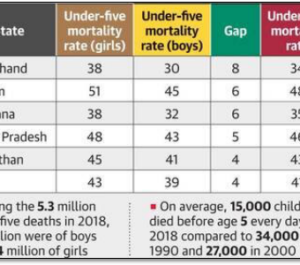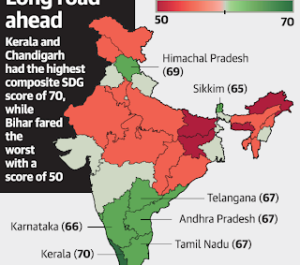The Global Talent Competitiveness Index 2020 (GTCI) report was launched by INSEAD, a partner and sponsor of the United Nations (UN) Sustainable Development Goals (SDGs) Tent in Davos, Switzerland.India has moved up eight places to the 72nd position from 80th position in GTCI 2019. In list of 132 countries Switzerland tops the list. According to the report the United States(USA) is at the 2nd position followed Singapore. Top10 list includes Sweden at 4th, Denmark at 5th, the Netherlands at 6th, Finland at 7th, Luxembourg at 8th, Norway at 9thand Australia at the 10th position. China was ranked at the 42ndplace, Russia at 48th position, South Africa at 70th position and Brazil at 80th
Switzerland tops the Global Talent Competitiveness Index 2020, India ranks 72nd
India’s under-5 girls face high mortality

India is among the few countries in the world where, in 2018, the mortality for girls under 5 years of age exceeded that of boys, according to the ‘Levels and Trends in Child Mortality’ report by the United Nations (UN) inter-agency group for child mortality. The report states that in 2018 fewer countries showed gender disparities in child mortality, and across the world, on average, boys are expected to have a higher probability of dying before reaching age-5 than girls. According to India’s 2017 Sample Registration System (SRS) the States with the highest burden of neonatal mortality are Madhya Pradesh, Odisha and Uttar Pradesh, with 32, 33 and 30 neonatal deaths per 1,000 live births, respectively. In this sense, Uttar Pradesh is the State with the highest number of estimated newborn deaths in India, both because of the high neonatal mortality rate and because of the large cohort of births that occur every year in the State,” noted information released by UNICEF (United Nations Children’s Fund). Half of all under-5 deaths in 2018 occurred in five countries: India, Nigeria, Pakistan, the Democratic Republic of the Congo and Ethiopia. India and Nigeria alone account for about a third. Current trends predict that close to 10 million 5- to 14-year-olds, and 52 million children under 5 years of age, will die between 2019 and 2030.
Kerala tops NITI Aayog’s index of UN goals

Kerala has retained its top slot, whileUttar Pradesh, Odisha and Sikkim have shown the most improvement. The second SDG-zero hunger –shown sharp divergence in the performance of States, with little middle ground, Kerala, Goa and parts of the north-east, including Mizoram, Nagaland, Arunachal Pradesh and Sikkim, have scored above 65, with Goa at 75 points. 22 of the States and Union Territories have scored below 50, with the central Indian States of Jharkhand, Madhya Pradesh, Bihar and Chhattisgarh scoring below 30, showing high levels of hunger and malnutrition. On the fifth SDG-gender equality – almost all States fare poorly. Only Jammu and Kashmir, Himachal Pradesh and Kerala have managed to cross 50 points, The indicators considered include crimes against women, eradicating sex selection and discrimination against daughters, and access to reproductive health schemes, as well as indicators showing women’s economic and political empowerment and leadership. The Swachh Bharat Mission has contributed largely to the high scores on the sixth SDG-clean water and sanitation – although that was helped by the fact that four out of seven indicators dealt with toilets and sanitation, while only one indicator was related to safe and affordable drinking water. All States and union Territories except for Delhi have scored above 65, with the national capital scoring poorly on the percentage of urban households with individual household toilets (less than 1%) and, oddly, providing no data on districts verified to be open defecation free.

